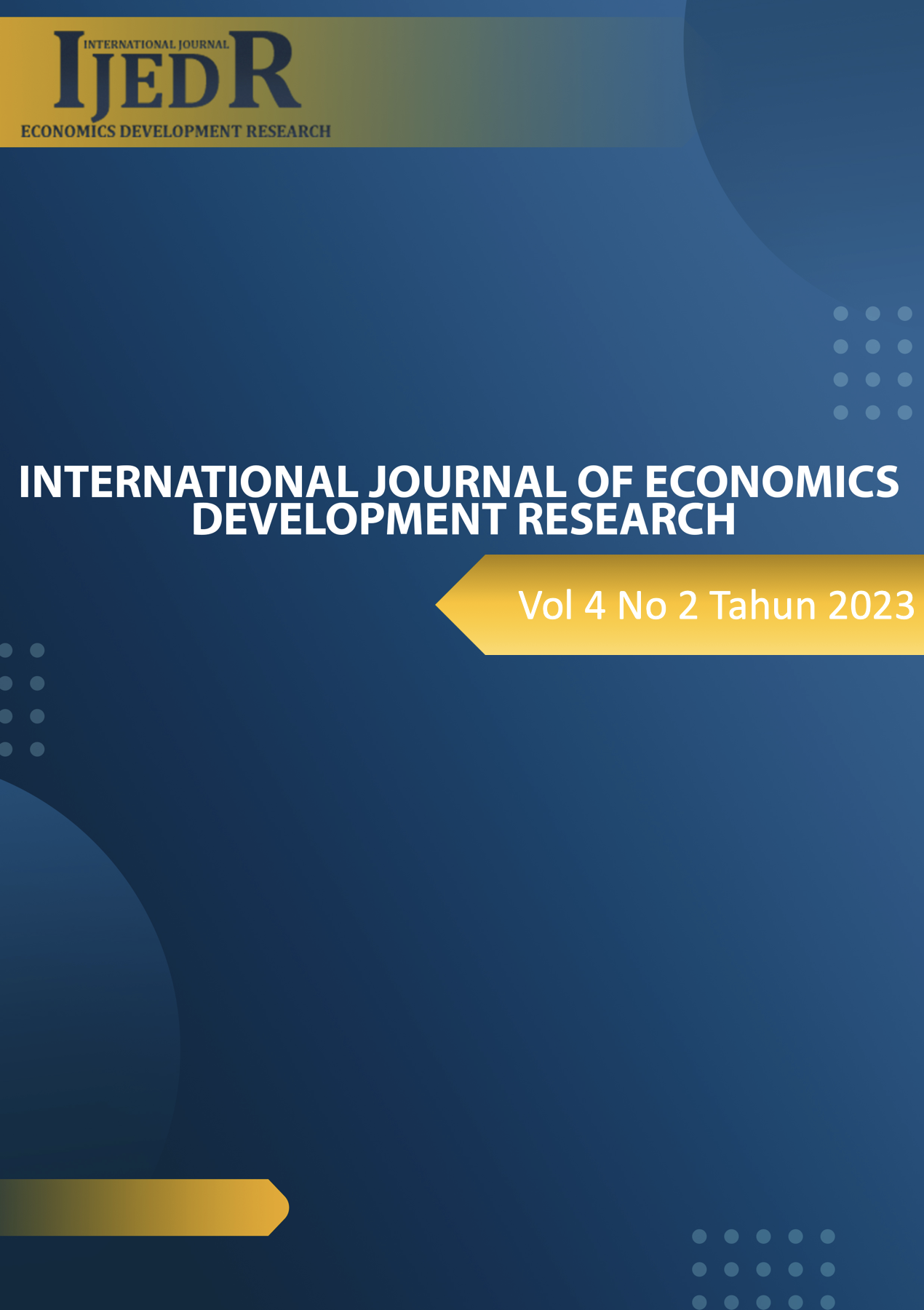Does Working From Home Affects Income ? Microdata Analysis Using Sakernas 2020
DOI:
https://doi.org/10.37385/ijedr.v4i3.2640Keywords:
Income, Sakernas, Multinominal logit, Working from homeAbstract
One of the measures taken by the government to stop the COVID-19 virus from spreading was to restrict community activities during the pandemic. The strategy is a shock to business movement and the work market. A pandemic has made financial specialists adjust to more readily dominant computerized innovation at work. They must be prepared to work from home. As a result, the primary objective of this research is to comprehend how employees' incomes are affected by working from home. The multinomial logit estimation technique was utilized in this investigation. The 2020 Indonesian National Labor Force Survey is the source of the statistics (SAKERNAS). Cross-sectional data on a number of factors, such as the economy, education, and a small set of demographics, are available in SAKERNAS. The findings indicate that businesses that allow employees to work from home typically experience a decline in income. More specifically, workers have yet to be able to maintain their household income levels thanks to the implementation of digitalization. According to this study, the increase in worker resilience during the pandemic was also influenced by socio-demographic factors: age, training experience, urban living, and educational attainment. The income loss brought on by the work-from-home strategy is closely related to the commercial sector. Several business sectors have different outcomes when work-from-home rules are implemented. The difference in impact is likely caused by a readiness to implement technology. With the goal that later on, it is important to increment computerized understanding and capability, particularly for areas encountering a decrease in pay.
References
Alon, T., Doepke, M., Rumsey, J., & Tertile, M. (2020). The impact of covid-19 on gender equality. NBER Working Paper, Working Paper 26947. https://www.nber.org/system/fles/working_papers/w26947/w26947.pdf
Arntz, M., Ben Yahmed, S., & Berlingieri, F. (2019). Working from Home: Heterogeneous Effects on Hours Worked and Wages. Centre for European Economic Research Discussion Paper, 19-015. http://dx.doi.org/10.2139/ssrn.3383408
Arntz, M., Ben Yahmed, S., Berlingieri, F. (2022). Working from home, hours worked and wages: Heterogeneity by gender and parenthood. Labour Economic, 76. 102169. https://doi.org/10.1016/j.labeco.2022.102169
Baudot, L., & Kelly, K. (2020). A Survey of Perceptions of Remote Work and Work Productivity in the United States during the COVID-19 Shutdown. SSRN J. https://doi.org/10.2139/ssrn.3646406
Bloom, N., Liang, J., Roberts, J., & Ying, Z.J. (2015). Does Working from Home Work? Evidence from a Chinese Experiment. The Quarterly Journal of Economics, 130(1). 165-218. https://doi.org/10.1093/qje/qju032
Brooks, M. M., Mueller, J. M., & Thiede, B. C., Brian. (2021). Rural-Urban Differences in the Labor-Force Impacts of COVID-19 in the United States. Socius: Sociological Research for a Dynamic World. 7. 237802312110220. 10.1177/23780231211022094.
Brynjolfsson, E., Horton, J.J., Ozimek, A., Rock, D., Sharma, G., & TuYe, H. (2020, June). COVID-19 and Remote Work: An Early Look at US Data. National Bureau of Economic Research Working Paper. Retrieved from https://www.nber.org/papers/w27344
Chiou, L., & Tucker, C. (2020). Social distancing, Internet access and inequality. NBER Working Papers 26982, National Bureau of Economic Research, Inc.
Diffenbaugh, N.S., Field, C.B., Appel, E.A. et al. (2020). The COVID-19 lockdowns: a window into the Earth System. Nat Rev Earth Environ 1, 470–481. https://doi.org/10.1038/s43017-020-0079-1
Dutcher, E. G. (2012). The effects of telecommuting on productivity: An experimental examination. The role of dull and creative tasks. Journal of Economic Behavior & Organization, 84(1). 355–363.
Figueroa, J. F., Wadhera, R. K., Mehtsun, W. T., Riley, K., Phelan, J., & Jha, A. K. (2021, March). Association of race, ethnicity, and community-level factors with COVID-19 cases and deaths across US counties. In Healthcare (Vol. 9, No. 1, p. 100495). Elsevier
Glass, J. L. & Noonan, M. C. (2016). Telecommuting and earnings trajectories among American women and men 1989–2008. Social Forces, 95(1). 217–250.
Kong, X., Zhang, A., Xiao, X., Das, S., & Zhang, Y. (2022). Work from home in the post-COVID world. Case Studies on Transport Policy, 10. 1118-1131. https://doi.org/10.1016/j.cstp.2022.04.002
ILO. (2020). Preventing Exclusion from the Labour Market: Tackling the Covid-19 youth unemployment crisis. ILO Policy Brief retrived from https://www.ilo.org/wcmsp5/groups/public/---ed_emp/documents/publi cation/wcms_746031.pdf
Jain, T., Currie, G., & Aston, L. (2022). COVID and working from home: Long-term impacts and psycho-social determinants. Transportation Research Part A, 156. 52–68. https://doi.org/10.1016/j.tra.2021.12.007
Kalenkoski, C.M., & Pabilonia, S.W. (2022). Impacts of COVID-19 on the self-employed. Small Bus Econ 58, 741–768. https://doi.org/10.1007/s11187-021-00522-4
Nivakoski, S., & Mascherini, M. (2021). Gender Differences in the Impact of the COVID-19 Pandemic on Employment, Unpaid Work and Well-Being in the EU. Inter economics, 56(5), 254–260. https://doi.org/10.1007/s10272-021-0994-5
Reyes, J. (2013). What Matters Most for Education Resilience: A Framework Paper. Washington D.C.: World Bank.
Shah, R., E. Maber, M. T. A. Lopes Cardozo, and R. Paterson. 2016. Peacebuilding, Education and Advocacy in Conflict Affected Context: UNICEF Programme Report. New York: UNICEF
USAID. (2018). Resilience Evidence Forum Report. Washington D.C.: Center For Resilience
Varela, A., J. Keicey, J. Reyes, M. Gould, and J. Sklar. 2013. Learning and Resilience: The Crucial Role of Social and Emotional Well-Being in Contexts of Adversity. Education Notes. Washington, D.C./New York: The World Bank and International Rescue Committee.
Verick, S. (2009). Who Is Hit Hardest during a Financial Crisis? The Vulnerability of Young Men and Women to Unemployment in an Economic Downturn. IZA Discussion Paper No. 4359. Retrieved from http://ftp.iza.org/dp4359.pdf.
Wang, B., Liu, Y., Qian, J., and Parker, S. K. (2021). Achieving effective remote working during the COVID-19 pandemic: A work design perspective. Appl. Psychol. 70, 16–59. doi: 10.1111/apps.12290
World Bank. (2018). World Development Report 2018: Learning to Realize Education’s Promise. Washington, D.C.: World Bank. https://doi.org/10.1596/978-1-4648-1096-1.





